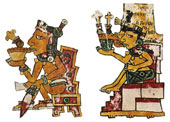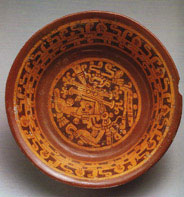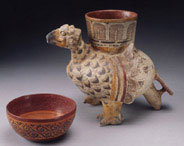Form and StylePre-Columbian art is renowned for its pervasive use of terra-cotta as a medium and many outstanding pieces can be seen at the Princeton University Art Museum. Production of the effigy censer was inspired by a reverent appreciation for what clay itself offered the artist as a product of nature. Kinship with the simple vessel is revealed in the body, which was built up meticulously from coils. Working this way, the artist carefully planned for the natural weight and sag of the wet clay in conceiving such a massive human image while simultaneously considering the mechanics of a chimney to send the gift of perfumed smoke to the spirit forces he intended to propitiate. No less significant a contribution, however, was the endowment of the effigy with a mirthful quality, a three-dimensional  Codex Borgia depicts a lord and lady drinking chocolate from ceramic bowls. They are typical of the Nahua-Mixteca style with enlarged heads and hands attached to wire-like limbs. |




